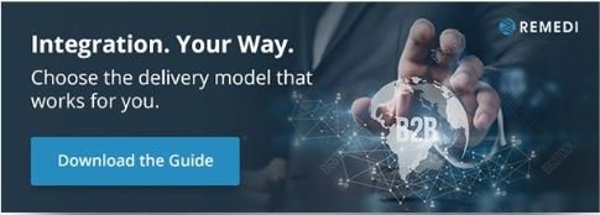
This is the third installment in our three-part series, “Integrationists Wanted.” The series examines the essential role EDI, MFT, EAI, and API specialists can play in helping to create value and competitive advantage for companies and organizations in an era of economic disruption.
Before the pandemic struck, when everyone was working and even digital laggards could afford to waste time dropping invoices in the mail, decision-makers could afford to put off investing in modern B2B integration solutions.
The question now is, who can afford not to?
While every industry was impacted, not every company was. Some found ways in 2020 to grow despite— and even because of— Covid-19.
What separates those organizations from the ones who are facing a harder path to recovery in 2021?
Mindset Over Toolset
As we explored in our first article in the series, what allowed some companies to increase revenue and find new opportunities during the pandemic was a mindset that looked at modernization projects through a simple filter:
How can this make our company easier to do business with?
As you consider the question, think about your business from the customer’s chair.
Working from home has spoiled people on fast and seamless online transactions—including B2B buyers.
B2B e-commerce research firm Digital Commerce 360 finds these buyers now want the ease and convenience of online transactions in their corporate roles.
That shift represents a huge opportunity for your organization—especially if you’re in an industry threatened by the move to self-serve like distribution.
In the current environment, your job isn’t IT— it’s finding ways to be the trading partner or supplier who can help take customer orders in a couple of clicks, or via a digital workflow like EDI.
Make It Easy on Customers
In our work and across the industries we follow, we’ve seen companies grow during the pandemic through adapting to the shifts in the economy and the buying behavior of B2B customers
According to Digital Commerce 360, sport fishing supplier Triple S doubled their online sales and traffic after rolling out their new B2B e-commerce site, TripleSSportingSupplies.com.
Be aware that just having a B2B online ordering portal alone didn’t transform their fortunes. Recognizing that B2B buyers wanted an easy, B2C-like experience allowed them to grow their business, not technology alone.
Similarly, the research firm reports that HVAC distributor Watsco, Inc. posted a Q2 online B2B sales increase to $447 million, up 29% from the previous year. Many of those sales came through the company’s mobile app.
This only makes sense—they cater to installers who often need to order when they’re out in the field.
The app allows Watsco to enable its customers to deliver faster solutions to unexpected issues and make homeowners with heating or cooling issues comfortable sooner than they could before.
Maturity Begins with Baby Steps
If reimagining the whole process for your customers is too heavy a lift, don’t get discouraged.
You may find you can build additional access points using your existing architecture and get more value from the integration investments you’ve already made.
For example, we helped a manufacturer of hand sanitizer reimagine how they deployed IBM’s Sterling B2B Integrator to bypass grocery store distribution bottlenecks. Looking beyond our client list we find many similar examples.
Or if leveraging currently deployed middleware isn’t feasible, start small and go for a quick win with something cheap and simple like a document conversion program.
Let’s say your company is still sending documents by fax or email attachment. If so, don’t be embarrassed—a 2019 IDC survey reports more than 33% of organizations still use manual forms and fax for their business transactions.
What if you could convert the 40 to 160 hours many companies spend on transactions sent by hand into more strategic tasks and apply those resources toward tasks that can’t be automated?
Utilizing a product like IBM Sterling Document Conversion Services (full disclosure, Remedi is an IBM Gold Partner) you can easily convert faxes, emails, and PDFs into an EDI format.
By the way, some vendors offer a free trial period to enable you to show proof of concept to before you sign, so you may be able to try a small-bore experiment without having to spend any money upfront.
Regardless of which solution you choose, the goal is to have between 30 and 90 days’ worth of quantifiable results such as fewer mistakes and lower costs to provide evidence to build on as you work toward a more complete solution.
Moving Forward
While we can’t predict what new challenges 2021 may bring, we can tell you from our own experience that making things easy for customers makes your company more valuable to them.
It also makes those with an integrationist mindset more valuable to their companies.
About Remedi
Remedi Electronic Commerce Group helps companies save time and money, provide a better customer experience, and quickly respond to new opportunities using integration and B2B ecommerce strategies built for a digitally driven economy.



